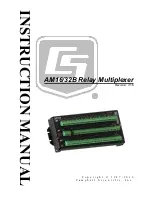
E N G L I S H
18
1. 3-3/4 digits, 4000 count LCD display.
2. Push-buttons for special functions &
features.
3. Selector to turn the power ON or OFF and
select a function.
4. Input terminal for 10A (20A for 30 sec.)
current measurement function.
5. Input terminal for milli-amps and micro-
amps current measurement function.
6. Common (Ground reference) input
terminal for all measurement functions.
7. Input terminal for all functions EXCEPT
current (A, mA, μA) measurement functions.
Glossary of Terms for Digital
Multimeters
Average sensing RMS calibrated
RMS (Root-Mean-Square) is the term used
to describe the effective or equivalent DC
value of an AC signal. Most digital multi
meters use average sensing RMS calibrated
technique to measure RMS values of AC
signals. This technique is to obtain the
average value by rectifying and filtering
the AC signal. The average value is then
scaled upward (that is, calibrated) to read
the RMS value of a sine wave. In measuring
pure sinusoidal waveform, this technique is
fast, accurate, and cost-effective. However,
in measuring non-sinusoidal waveforms,
significant errors can be introduced because
of different scaling factors relating average
to RMS values.
True-RMS
True-RMS is a term which identifies a DMM
that accurately responds to the effective
RMS value regardless of the waveform
shapes such as square, sawtooth, triangle,
pulse trains, spikes, and transient glitches
as well as distorted waveforms with the
presence of harmonics.
Non-sinusoidal waveforms may cause :
-Overheated transformers, generator and
motors to burn out faster than normal.
-Circuit breakers to trip prematurely.
-Fuses to blow.
-Neutrals to be overheated due to the triple
harmonics presence the neutral.
-Bus bars and electrical panels to vibrate.
Crest factor
Crest Factor is the ratio of the Crest
(instantaneous peak) value to the True-RMS
value, which is commonly used to define the
dynamic range of a True-RMS DMM. A pure
sinusoidal waveform has a Crest Factor of
1.414.
A badly distorted sinusoidal waveform
normally has a much higher Crest Factor.
NMRR (Normal Mode Rejection Ratio)
NMRR is the DMM’s ability to reject
unwanted AC noise effect which can cause
inaccurate DC measurements. NMRR is
typically specified in terms of dB (decibel).
The Meter has a NMRR specification of >
60dB at 50Hz/60Hz, which means a good
ability to reject the effect of AC noise in DC
measurements.
Содержание UD112
Страница 30: ...30 NOTAS NOTES ...
Страница 31: ...31 NOTAS NOTES ...















































